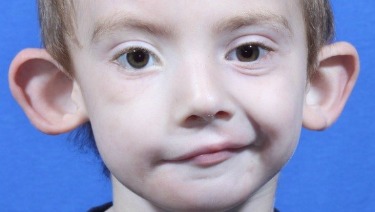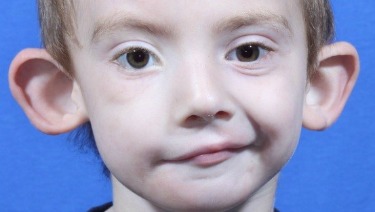Half a Abbay Face Half a Baby Face
Children with Facial Asymmetry


Page Content
All people take disproportionate faces. When one looks closely, these differences become more apparent. However, there are conditions in children in which the normal minor differences are much more significant.
Craniofacial Microsomia
Children born with this congenital status have one half of the face that didn't develop likewise as the other. It occurs during fetal evolution.
Common affected areas:
-
Ear: Anything from a change in shape to an absent ear
-
Ear canal: May be absent with decreased hearing as a result
-
Lower jaw (mandible): Less growth, chin point to side of decreased growth, and abnormal bite
-
Facial motion: A unmarried nerve (facial nerve) with many branches controls facial move, and one or more of these may be affected
-
Eye socket and/or eye: May be pocket-sized or absent. Whatsoever the kid is built-in with, he/she will maintain, but it volition not go worse with growth.
These children are cared for past a craniofacial team, including a pediatric plastic surgeon, ENT surgeon, speech therapist, dentist, and orthodontist. Surgery may exist needed to help the jaw grow and to reconstruct the ear. Why this status occurs is non fully understood, although genetic and environmental factors are both probable.
Congenital Facial Nerve Palsy
On each side of the face, at that place is one main facial nerve with several branches that travel to the muscles of facial expression. Children can be born with a deficiency of this nervus, commonly on 1 side. Sometimes both nerves are afflicted. This is a rare problem.
The causes of congenital facial nerve palsy are usually birth trauma or developmental.
-
Developmental: When i side is affected, it is typically seen as muscular weakness, with difficulties raising the eyebrow, closing the eye, feeding difficulties, or smiling on the affected side. A bilateral (both sides) course of this problem is known as Mobius Syndrome. Mobius syndrome is a congenital paralysis of the muscle of facial expression, ordinarily due to deficiency of the facial nerve also as one of the nerves controlling move of the eye.
-
Birth trauma: 90% of the cases related to birth trauma will improve without handling. If it does non go away spontaneously, and then based on the location of the nerve damage, a surgical procedure called a neurorrhapy (stitching nerve ends together) or nervus graft may exist performed to restore normal nerve function.
Bated from the inability to communicate to others with facial expression, children with facial nervus weakness/paralysis may take difficulty closing the eye on the affected side, and thus take eye irritation and/or corneal ulceration. Prolonged exposure can lead to infection or loss of vision.
At that place are two forms of treatment:
-
Eye protection: A small weight is surgically placed into the upper eyelid on the affected side. This volition go far easier to shut the eye, with the goal of keeping the cornea protected, and the eye free of infection.
-
Grinning recreation: The ability to smile can exist restored either past transferring one of the surrounding muscles of the face to the corner of the oral fissure, or by implanting a new muscle taken from another part of the patient'south body. With new muscle, arteries, veins, and nerves must be reconnected under a microscope to restore function. The nerve that powers the new muscle comes either from a chewing muscle on the aforementioned side of the face or from a normal facial nervus branch on the patient's other side.
Caused Facial Nerve Palsy
Children tin can develop facial nerve weakness/paralysis during life due to trauma, tumors, or from a third condition called Bong'south palsy. Bell's palsy is idea to result from a viral infection that affects the facial nervus, and therefore ofttimes results in a unilateral (one-sided) facial paralysis. With time, the nerve can regain function. Many children get total office dorsum, while others regain only partial part. In the instance of no return of role, treatment can be offered as described to a higher place for congenital cases.
Boosted Data:
-
What is a Pediatric Plastic Surgeon?
-
Guidelines for Referral to Pediatric Surgical Specialists
-
Flat Head Syndrome & Your Baby: Information near Positional Skull Deformities
Article Body
- Concluding Updated
- ix/29/2016
- Source
- Section on Plastic Surgery (Copyright © 2016 American Academy of Pediatrics)
The data contained on this Web site should not be used as a substitute for the medical care and advice of your pediatrician. There may exist variations in treatment that your pediatrician may recommend based on private facts and circumstances.
Source: https://www.healthychildren.org/English/health-issues/conditions/Cleft-Craniofacial/Pages/Children-with-Facial-Asymmetry.aspx
0 Response to "Half a Abbay Face Half a Baby Face"
Enviar um comentário